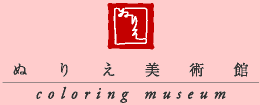« NYでのぬりえ展が共同通信で配信されました | メイン | きよみさんの「おどりのおけいこ」 »
The Japan Times のニュース(英文)
Wednesday, Oct. 18, 2006
Postwar 'nurie' coloring pages N.Y. hit
By CRYSTAL WONG
NEW YORK (Kyodo) Artist Kiichi Tsutaya's "nurie" coloring pages, beloved by postwar Japanese kids, are deceptively simple and instantly arresting -- a little girl with bright eyes, a round face and chubby legs, dressed in a cute Western dress or a traditional Japanese costume, peering out at you impishly in black-and-white outline.
For the first time, Tsutaya's nurie series, considered an important influence in Japanese pop culture, is being exhibited in New York a year after his death at age 91. Like most Japanese exports here, it was met with an enthusiastic reception.
"I want to color them in," Isabelle Clark, 11, said eagerly at the recent opening of "Nurie -- The Japanese Picture Coloring Exhibition" at the Onishi Gallery in New York's Chelsea district.
Her friends Remy Moorhead and Mariko Sredojev, both 11, agreed.
"They look fun and they're cuter than American coloring books," Sredojev said, while Moorhead found American coloring books "plain" and liked that Tsutaya's nurie were hand-drawn.
Masa Kaneko, 57, Tsutaya's niece and owner of the Nurie Museum in Tokyo, said many Japanese were so poor after the war that often "they just looked at it in the stores."
Friends would pool their money to share one nurie set, which cost about 5 yen in the 1940s, she said.
During its heyday in the 1950s, sales of Tsutaya's nurie, sold in packets of five to eight sheets with a colorful image on the front, averaged 1 million units a month, with a high of 1.6 million.
Nurie declined with the rise of TV in Japanese homes in the 1960s, Kaneko said.
Tsutaya said his nurie, particularly their distinctive eyes, were influenced by Western figures, including French dolls, Shirley Temple, actress Clara Bow and American cartoon idol Betty Boop.
The girls in his nurie often had wavy hair, Western dress and lounged on Western furniture, reflecting the American influence on Japanese culture after the war.
Yet the artist's drawings all adhered to a distinctively Japanese aesthetic through the delicate brushwork due to his training in Japanese painting, the way the girl's heads are cocked slightly or the depiction of girls dressed in kimono for traditional events, such as Hinamatsuri, the Doll's Festival.
The drawings, slightly larger than a postcard, also featured a short descriptive caption and the artist's signature.
Guests at the opening reception acknowledged the "cuteness" of the drawings but also said they were impressed by Tsutaya's artistry and detail.
"It's really unusual when you walk in and all of the faces on one wall are kind of in the same position," said children's illustrator Liz Eck. "It's really hard to capture a really simple child's stance like he does, the sweetness and the delicateness."
Kaneko, who opened the Nurie Museum in 2002, plans to bring the exhibition to Germany, France and possibly back to New York within the next three years.
"I'm very happy that people in New York enjoyed and recognize that in Japan there are such beautiful coloring pictures," she said.
The Japan Times
(C) All rights reserved
投稿者:Webmaster |投稿日:06/10/18 (水)
トラックバック
このエントリーのトラックバックURL:
/377
